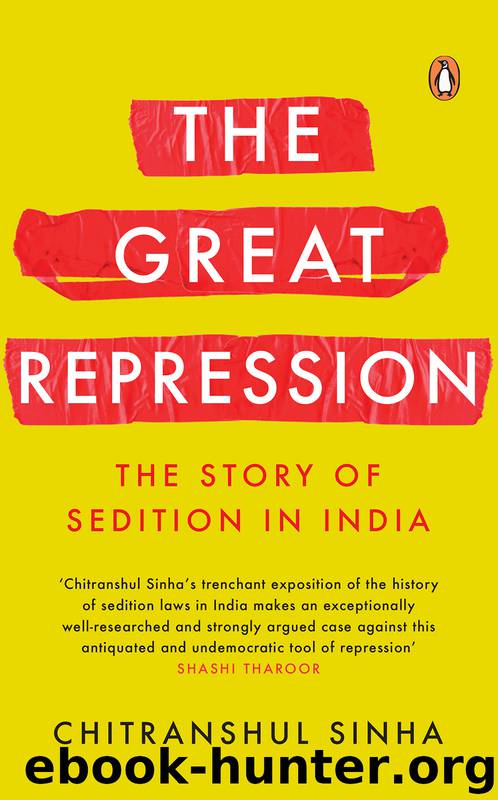The Great Repression by Chitranshul Sinha

Author:Chitranshul Sinha
Language: eng
Format: epub
ISBN: 9789353056186
Publisher: Penguin Random House India Private Limited
Published: 2019-08-02T00:00:00+00:00
This passage is quite illuminating. The British saw oppressed masses fighting to take back their country as ‘evil desperados’!
As a parting shot, clearly a fallout of the Ghadr Movement, the committee suggested the restriction of ingress into India. It was recommended that the government may prohibit or restrict the ingress of Indians returning to their homeland if it deemed it fit to do so to protect the country’s safety, interests and tranquillity. It recognized the threat from foreign entities and persons who were purportedly conspiring to cause seditious violence within India.
As mentioned, the Defence of India Act formed the core basis for the Sedition Committee report. The said Act along with other emergency laws had a major impact in Punjab. At the Amritsar session of the Indian National Congress in 1919, Motilal Nehru in his presidential address said, ‘The years 1915 to 1917 were occupied with various conspiracy trials by special tribunals constituted under the Defence of India Act. The vernacular press was ruthlessly suppressed and hundreds of persons were interned under the Defence of India Act or the Ingress Ordinance. It was during this period that Lokmanya Tilak and Srijut Bipin Chandra Pal were prohibited from entering the province lest they should introduce the virus of Home Rule here.’ 35
The report amply demonstrates that the age of moderation was past, and nationalists were gaining more ground than the moderates. The extremists who had split from the Congress received a boost with the release of Tilak from prison in 1914, rejoining the Indian National Congress at the session in 1916.
The same year also saw the birth of the Home Rule League in India founded by Annie Besant, a British lady who was the president of the Theosophical Society and a champion of the Indian freedom cause. Another Home Rule League had been established by Tilak to champion the cause of self-government within the British Empire by constitutional means. Tilak undertook a campaign calling for Swaraj by publishing article after article espousing the cause of self-government in his two vernaculars, Mahratta and Kesari. Tilak’s speeches and appeals to the masses earned him the sobriquet ‘Lokmanya’, which means revered by the masses. Tilak and Besant worked together with Tilak’s Home Rule League in Bombay and the Central Provinces and Besant’s Home Rule League working in the rest of India.
This invited the third prosecution for sedition against Lokmanya Tilak. He was accused of spreading sedition through his speeches delivered in Marathi while on his lecture tour to spread the message of Home Rule and Swarajya. He was prosecuted for three specific speeches, one at Belgaum on 1 May 1916 and two at Ahmednagar on 31 May and 1 June 1916. However, he was not prosecuted under Section 124A of the IPC as in the earlier two prosecutions. 36 This time he was prosecuted under Section 108 of the Criminal Procedure Code as enacted in 1898, which was the precursor to the current Indian Criminal Procedure Code. Section 108 empowered the chief magistrate in
Download
This site does not store any files on its server. We only index and link to content provided by other sites. Please contact the content providers to delete copyright contents if any and email us, we'll remove relevant links or contents immediately.
| Antitrust | Civil Law |
| Emigration & Immigration | Federal Jurisdiction |
| Housing & Urban Development | Indigenous Peoples |
| Land Use | Public |
| Public Contract | Public Utilities |
| Urban, State & Local Government |
Machine Learning at Scale with H2O by Gregory Keys | David Whiting(4169)
Killers of the Flower Moon by David Grann(3967)
Oathbringer (The Stormlight Archive, Book 3) by Brandon Sanderson(2870)
Will by Will Smith(2789)
Once Upon a Broken Heart by Stephanie Garber(2665)
Guns, Germs and Steel by Diamond Jared(2303)
Borders by unknow(2227)
It Starts With Us (It Ends with Us #2) by Colleen Hoover(2194)
Friends, Lovers, and the Big Terrible Thing by Matthew Perry(2116)
The Room Where It Happened by John Bolton;(2102)
The Color of Law by Richard Rothstein(1885)
The Strength In Our Scars by Bianca Sparacino(1776)
HBR's 10 Must Reads 2022 by Harvard Business Review(1776)
A Short History of War by Jeremy Black(1758)
Water Rights and the Environment in the United States by John Burch(1642)
Examples & Explanations: Administrative Law by William F. Funk & Richard H. Seamon(1601)
515945210 by Unknown(1597)
A Game of Thrones (The Illustrated Edition) by George R. R. Martin(1586)
That Every Man Be Armed by Stephen P. Halbrook(1548)
